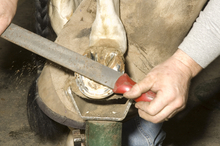Fall, followed closely by wet winter weather is here in many areas and that means dealing with rain, slush, snow and a lot of wet hooves on horses and other equines.

Keeping horse hooves healthy
Putting horses up at night when the ground is wet will result in stronger feet and fewer lost shoes.
Dampness can create problems with horses' hooves and with the shoeing of horses. In The Farrier's Journal, Matt Calahan, a farrier from Huntsville, Ala., offers his views on dealing with wet hooves:
Don’t assume moisture isn’t a problem, just because it isn’t raining. “In Alabama, our wet hooves issues are due to the heavy amounts of dew on the grass that starts about 5:30 p.m. and stays until noon the next day.
A wet hoof is a bigger hoof. “When the foot is completely expanded (soaked) you get a nice, tight fit with the shoe and secure nails. The foot looks perfect. As soon as it dries out, and contracts all the way down to normal size, you get a little less pressure with your nails and the shoe will have a tendency to move around and come loose.”
Trim wet hooves with care. “Most of the horses that have waterlogged, unhealthy hooves have less foot than I would take off in a normal trim. It becomes more of a challenge to relive sole pressure than any worries about trimming … The goal becomes to skim the sole out so that you can relieve sole pressure and still leave enough for the sole to grow out.
Shift your nail patterns between shoeings. “I’ll use, for example, the first and third hole during one cycle and then the next time, the second and fourth hole.”
Calahan also advises horse owners to put their horses up at night when the ground is wet whether from dew, rain, or snow. "Putting horses up at night when it’s wet will result in stronger feet and fewer lost shoes.”
In addition to the advice from Calahan, most horse owners realize that they have a major responsibility in making sure that each horse's hooves and lower limbs are frequently checked for injury, damage, disease or any condition that might affect the soundness of the horse.
Knowledge of the anatomy of the horse's foot including the hoof and all its internal structures is of paramount importance in being able to assess the condition of the horse's lower limbs and feet.
Damage and injury are usually evidenced by lameness, wounds, lacerations or abrasions, cracks in hoof wall, tenderness to the touch, or other visual clues and getting advice from a farrier promptly when a hoof issue arises can save not only the horse, but also time and money for the horse owner.
